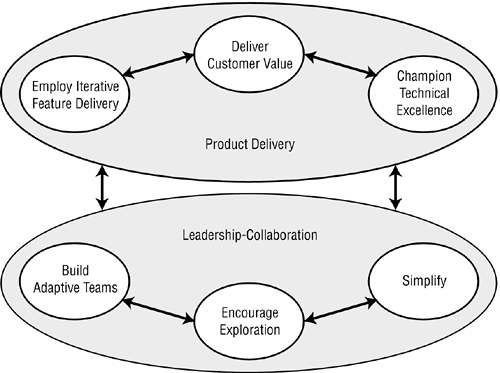The Guiding Principles of Agile Project Management
Individual knowledge, the interactions of knowledgeable team members , and the team's ability to learn and apply new knowledge drive success. Success in an agile context is about people and their interactions, not structure and process. And since people are guided by their value systems, creating agility depends on aligning the environment with their value systemswhich is why implementing APM will be nearly impossible for some teams and organizations. APM is value driven because people are value driven. A team can employ agile practices, but it won't achieve the potential benefit of agile development without embracing agile values and principles.
According to Carl Larson and Frank LaFasto (1989), whose research is source material for a long list of teamwork books, principled leadership is one of the most critical of the eight characteristics of effective teams. In high-performance teams, "the leaders managed the principles, and the principles managed the team."
Six principles, derived from the core values of the Agile Manifesto, guide APM (see Figure 2.1). Without these guiding principles, even seemingly agile practicesiterative delivery, for exampleare often used in the wrong way, or even worse , used such that teams consider themselves agile when they aren't. These guiding principles can help teams determine what practices are appropriate, generate new practices when they are necessary, evaluate new practices that arise, and implement practices in an agile manner. The six principles are divided into two categories, one product and customer related and the other management related :
Figure 2.1. APM Guiding Principles

Customer Value through Innovative Products
- Deliver Customer Value
- Employ Iterative, Feature-Based Delivery
- Champion Technical Excellence
Leadership-Collaboration Management Style
- Encourage Exploration
- Build Adaptive ( Self-Organizing , Self-Disciplined) Teams
- Simplify
These six principles form a system-of-principlesthey work together effectively. While separately each principle may be helpful, the six together create an environment that encourages emergent results. For example, delivering customer value and encouraging exploration are both linked to building self-organizing teams. The linkage reminds us that the product is built by the interactions of competent individuals who are constantly self-organizing. Similarly, championing technical excellence and encouraging exploration are linked in that one key goal of design should be to reduce the cost of change.
This chapter will address the customer- and product-oriented guiding principles, and Chapter 3 will cover the management principles.
The Agile Revolution
- Innovative Product Development
- Reliable Innovation
- Core Agile Values
- Agile Project Management
- Thriving in a Chaordic World
- Our Journey
Guiding Principles: Customers and Products
- Herman and Maya
- The Guiding Principles of Agile Project Management
- Deliver Customer Value
- Employ Iterative, Feature-Based Delivery
- Champion Technical Excellence
- Customers and Products
Guiding Principles: Leadership-Collaboration Management
- Management Style
- The Business of APM
- Leadership-Collaboration Management
- Encourage Exploration
- Build Adaptive (Self Organizing, Self Disciplined) Teams
- Simplify
- Principles to Practices
An Agile Project Management Model
- Principles and Practices
- An Agile Process Framework
- Phase: Envision
- Phase: Speculate
- Phase: Explore
- Phase: Adapt
- Phase: Close
- Judgment Required
- Project Size
- Agile Practices
The Envision Phase
- Get the Right People
- Phase: Envision
- Practice: Product Vision Box and Elevator Test Statement
- Practice: Product Architecture
- Practice: Project Data Sheet
- Practice: Get the Right People
- Practice: Participant Identification
- Practice: Customer Team-Developer Team Interface
- Practice: Process and Practice Tailoring
- Envision Summary
The Speculate Phase
- Scope Evolution
- Phase: Speculate
- Practice: Product Feature List
- Practice: Feature Cards
- Practice: Performance Requirements Cards
- Practice: Release, Milestone, and Iteration Plan
- Speculate Summary
The Explore Phase
- Individual Performance
- Phase: Explore
- Practice: Workload Management
- Practice: Low-Cost Change
- Practice: Coaching and Team Development
- Practice: Daily Team Integration Meetings
- Practice: Participatory Decision Making
- Practice: Daily Interaction with the Customer Team
- Explore Summary
The Adapt and Close Phases
- Progress
- Phase: Adapt
- Practice: Product, Project, and Team Review and Adaptive Action
- Phase: Close
- Adapt and Close Summary
Building Large Adaptive Teams
- An Achilles Heel?
- The Scaling Challenge
- A Scaled Adaptive Framework
- A Hub Organizational Structure
- Self-Organization Extensions
- Team Self-Discipline
- The Commitment-Accountability Protocol
- Is It Working?
- Structure and Tools
- Summary
Reliable Innovation
EAN: 2147483647
Pages: 96
